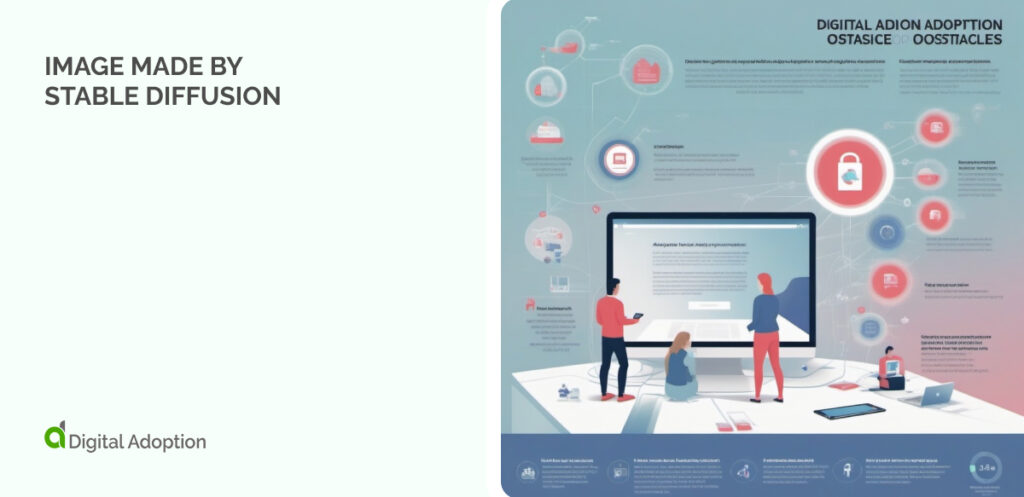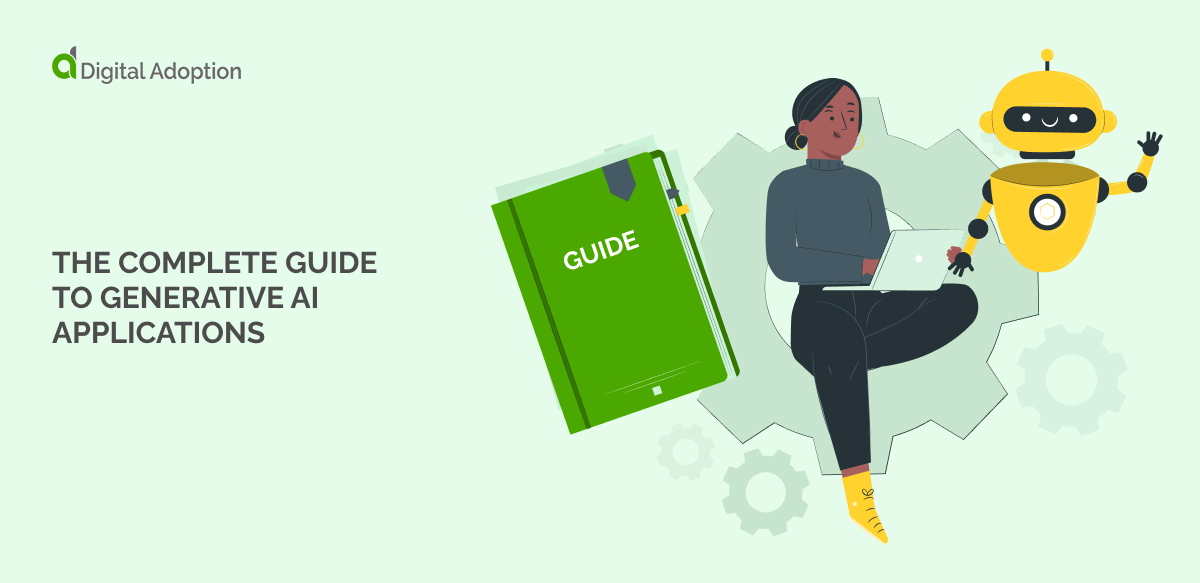However you feel about it, generative AI applications are widespread and here to stay in the business world. In other words, the AI-driven digital transformation has arrived, and your success depends on how you utilize it.
Generative AI or generative artificial intelligence apps use AI to create new content, like text, images, music, audio, and videos.
They use foundation (large AI models) to multi-task and perform out-of-the-box tasks, including summarization, Q&A, classification, and more. Plus, with minimal training, foundation models can be adapted for targeted use cases with minimal example data to help support your AI-augmented workforce of the future.
And with 60% of companies undergoing AI adoption already using generative AI, it’s a case that if you can’t beat them, join them. Enterprises ignoring generative AI will eventually become ignored by customers if they don’t keep up with the most pivotal AI trends.
Below, we explore the most popular examples of generative AI and the types of these apps to make you feel comfortable experimenting and trying out apps that might be perfect for many text or image-based enterprise needs that save time and free your staff to focus on higher-level tasks.
What are the most popular examples of generative AI?
Are you excited to start your digital adoption of generative AI apps but confused about which app to begin with? See below for the most common examples of generative AI to help you decide which is best for whatever enterprise use cases you may have identified, beginning with one you’ve probably heard of, ChatGPT.
ChatGPT
ChatGPT is an innovative AI tool developed by OpenAI that comprehends and generates human-like text.
Operating on the GPT (Generative Pre-trained Transformer) architecture, it utilizes large language models comprising billions of parameters. ChatGPT learns the details of human language structure, semantics, and context through pre-training on vast text data.
ChatGPT facilitates diverse tasks, including answering questions, creative content generation, assistance, and natural language communication. Its versatility spans industries, excelling in email drafting, coding, content creation, tutoring, and translation due to its human-like text generation prowess.
Applicable across nearly all business industries, it excels in tasks like email drafting, coding, content creation, tutoring, and translation thanks to its human-like text generation capabilities.
Stable Diffusion

Stable Diffusion is an image generation tool that employs a generative model trained through a diffusion process, evolving random noise (user input data) into clear, usable data samples.
With applications spanning art, design, and entertainment, Stable Diffusion offers versatile creative possibilities.
The image produced by Stable Diffusion exemplifies its capability to generate high-quality visuals across diverse creative domains. It is handy for marketing teams to produce creative images quickly and cheaply.
Midjourney

Midjourney is another versatile and powerful image generation tool, similar to Stable Diffusion. This platform harnesses the power of AI to create captivating and original artworks.
Using advanced generative models, Midjourney generates high-quality digital art pieces that push the boundaries of creativity.
These generative models are trained on vast datasets, enabling Midjourney to understand and replicate artistic styles and concepts.
Users can input parameters or prompts, such as desired themes or visual elements, and Midjourney produces unique artworks based on these inputs.
The platform leverages cutting-edge AI techniques to evolve and refine its artistic capabilities continually, offering users an immersive and limitless creative experience.
DALL-E
DALL-E is another AI creation from OpenAI, but instead of using AI to generate text like ChatGPT, DALL-E is an image-generation tool that brings user descriptions to life through stunning visual representations.
It utilizes advanced generative models to transform textual prompts into intricate and imaginative images, showcasing an unprecedented fusion of language and visual art.
Users can input diverse prompts, ranging from simple concepts to complex scenarios. DALL-E responds with striking visuals that reflect its remarkable ability to interpret and create from textual input.
Types of generative AI applications
Eight main types of generative AI applications exist. It is essential to align your needs to the abilities and features of a generative AI app to ensure you optimize its use, don’t waste investment, and avoid employee frustration.
The first type is image generation and manipulation, examples you have read above, like Stable Diffusion and DALL-E.
1. Image generation and manipulation
Generative AI is useful in image generation, often through converting text to images. Users input textual descriptions of desired images, prompting the AI tool to craft realistic visuals tailored to their specifications. This flexibility enables users to customize images by specifying subjects, styles, settings, or objects.
Beyond text-to-image functions, AI tools also specialize in image enhancement and manipulation.
These tools offer a range of features, including:
- Image completion.
- Image manipulation.
- Image super-resolution.
- Semantic image-to-image translation.
These capabilities empower users to adjust and refine images according to their creative objectives, enhancing their versatility and applicability in various contexts.
2. Software and coding
Generative AI revolutionizes software development and coding, offering innovative solutions that streamline coding processes. And if you’re wondering what this has to do with enterprise businesses, think again! Custom software is a popular and flexible way to ensure your enterprise gets the tools it needs depending on organizational goals, staff needs, and changing customer expectations.
The AI transformation has positioned software development as one of the leading use cases for generative AI, promising to elevate code quality, boost productivity, and inspire new software innovations.
Generative AI impacts software and coding in various ways:
Code Generation
By training AI models on extensive code repositories, generative AI can create code functions, snippets, or programs based on specified requirements. This automation accelerates development by handling repetitive tasks, freeing developers to focus on higher-level design and problem-solving and making the best software for your organization.
Code Completion
Generative AI enhances coding efficiency by providing intelligent code completion and suggestions. Integrated development environments (IDEs) leverage AI models to predict future code lines, speeding up coding and reducing errors.
Natural Language Interfaces
Generative AI enables natural language interfaces for coding, allowing developers to interact with software systems using human language. This feature bridges the gap between domain experts and developers, streamlining communication and reducing the need for specialized expertise.
Automated Testing
Generative AI-powered tools automate test case generation, a traditionally time-consuming aspect of software development. These tools analyze code and potential execution paths to generate comprehensive test suites, improving code coverage and identifying issues early in the development lifecycle.
3. Video creation
Generative AI applications simplify video production by offering highly adaptable and efficient features that produce top-notch video content.
These applications utilize generative AI models to automate video compositions, animations, special effects, and editing tasks. Like image generation, generative AI tools for video production can generate videos from scratch, enabling resolution, manipulation, and completion enhancements.
Additional functions of video generation AI tools include:
- Video style transfers: These tools generate new videos in the style of a reference image or video, enhancing visual consistency.
- Video predictions: AI tools predict future video frames, understanding spatial and temporal elements to create accurate sequences.
Generative AI applications also excel in 3D shape generation, constructing models and shapes through autoregressive models, GANs, and VAEs. This capability is invaluable for creating intricate 3D images that may be challenging to produce manually.
4. Audio generation
Generative AI finds extensive application in audio generation, expediting the creation process across various domains. This application of AI includes three primary use cases:
Text-to-speech (TTS) generators
Often based on GANs, TTS generators produce lifelike speech audio from textual prompts. These AI tools leverage vast datasets of text and speech to train models, enabling the generation of high-quality audio from text. They are helpful in speech-based interfaces, assistive technologies, and speech-enabled devices.
Music composition
Generative AI excels in music creation, generating new pieces based on learned music styles and patterns. This capability has widespread applications in music production, enabling the generation of complete audio compositions.
Speech-to-Speech (STS) conversions
STS conversions involve creating new speech or voices from existing audio files. This feature is particularly popular in industries like gaming and film, where professionals utilize AI tools with STS conversion capabilities to seamlessly generate voiceovers and audio content.
5. Text generation and summarization
ChatGPT is a leading example of text-generative AI tools that generate and summarize textual content based on user prompts. Leveraging generative AI models, such tools are trained on extensive datasets to produce updated and authentic content.
Below are several common applications of generative AI for text generation and summarization:
Content creation
Generative AI models assist in producing diverse written content, from blogs to marketing materials and social media posts. Additionally, tools like ChatGPT expedite writing tasks by generating ideas, quotes, and content outlines.
Language translation
Generative AI models can be tailored for translation tasks, accurately analyzing texts in one language and providing translations in another.
Virtual assistants and chatbots
Generative AI powers virtual assistants and chatbots, enabling them to deliver contextually relevant and natural responses during user interactions. Developing chatbots such as ChatGPT is a prominent application of generative AI, enhancing user engagement and offering personalized assistance.
Content aggregation
Beyond content creation, generative AI tools summarize extensive texts like research papers, news articles, and emails, providing users with concise overviews. Document summarization aids businesses in streamlining tasks involving large volumes of text.
Automatic report generation
In business intelligence and data analysis, generative AI simplifies complex datasets, generating detailed reports. This feature facilitates decision-making and enhances stakeholders’ comprehension of trends, patterns, and insights.
6. Organizational collaboration
Recent advancements in generative AI applications have revolutionized business collaboration. Automation now augments personal productivity tools like word processing and email, enhancing users’ accuracy and efficiency across organizations.
Microsoft’s integration of GPT-3.5 into Teams Premium exemplifies generative AI’s collaboration benefits. This implementation improves meeting recordings by automatically segmenting them, generating titles, and inserting personalized markers for easier reference.
Another notable instance is Jasper.ai, a widely acclaimed startup leveraging generative AI. It streamlines writing tasks by automating various processes, from crafting job descriptions to generating marketing copies, using its robust automation capabilities.
This feature demonstrates how generative AI enhances team collaboration and productivity, offering innovative solutions for various business needs.
7. Chatbot performance improvement
While chatbots stand out as a leading application of generative AI, this technology also plays a pivotal role in enhancing their performance and capabilities. Doing so fosters more engaging and effective interactions between chatbots and users, primarily leveraging generative models and natural language processing (NLP).
Generative AI is often helpful to chatbot performance in several ways:
NLU Enhancement
Generative AI models enhance a chatbot’s natural language understanding (NLU) by learning intricate language patterns, context, and nuances from vast text datasets. It enables chatbots to better grasp user inputs, extract intent, and identify entities.
Human-like response generation
Generative AI enables chatbots to produce human-like text, a crucial aspect of improving conversational quality. Training chatbots on diverse conversational data teaches them to generate natural and tailored responses, enhancing user engagement.
Handling open-ended prompts
Unlike traditional rule-based chatbots, generative AI empowers chatbots to handle unfamiliar topics or open-ended queries more effectively. By training on extensive conversational data, chatbots can generate plausible responses to a broader range of queries, increasing flexibility.
User profiling
Generative AI facilitates chatbots in creating user profiles by analyzing past conversations to understand preferences. This personalized approach allows chatbots to tailor responses and recommendations, offering users a more customized experience and improving engagement by implementing ChatGPT sales features.
8. Enterprise search
Finally, a recent application of generative AI involves integrating into enterprise search systems for enhanced efficiency.
Leveraging generative AI, organizations can expedite information retrieval, as these models can securely scan vast repositories of organizational documents such as contracts, research reports, and business analyses.
Furthermore, developers can train generative AI models to automatically identify and highlight crucial sections within documents, enabling enterprise members to locate the required information swiftly.
Make generative AI adoption your goal this year
Generative AI apps have many use cases, and now is the time to invest or lag behind your competitors.
AI image and text generation are helpful for marketing, faster customer query responses, and allowing your design teams to let their imagination run riot on a fraction of the budget.
For all these reasons, make AI adoption your goal for this year, to innovate quickly at a low cost and see your revenue rise and your staff’s imaginations soar as the sky becomes the limit for the creativity and innovation of your enterprise.













